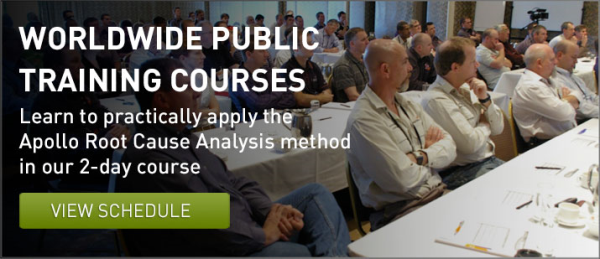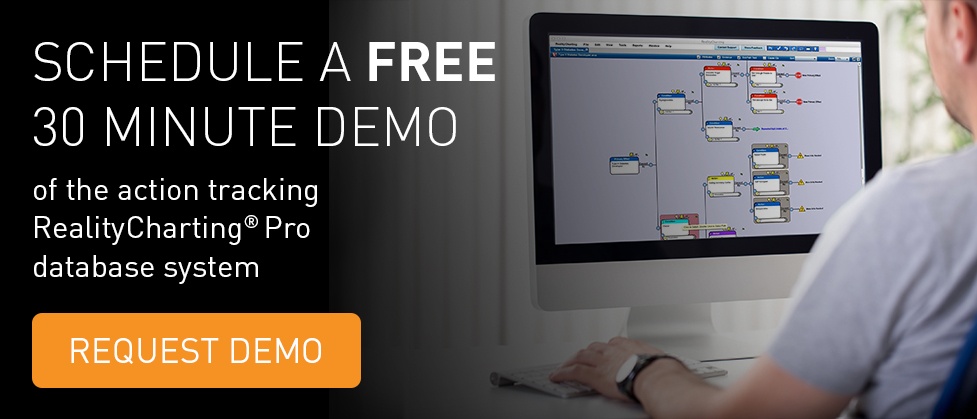FEATURED BLOG
What to Expect During RCA Facilitator Training
Posted by Jessica Peel on Thu, Jan 19, 2017 @ 07:01 AM
Topics: root cause analysis, rca facilitator, rca skills, RCA Training
Actions or Conditions: What is the Difference and Why Does it Matter?
Posted by Jack Jager on Fri, Aug 12, 2016 @ 03:08 AM
One of the four basic principles in the Apollo Root Cause Analysis methodology is that for each effect there are at least two causes and these causes are either actions or conditions. 
This principle causes you to think more critically, challenge causal relationships more consistently, and to understand that things are rarely as simple as they may seem.
One implication of this principle is that there should never be a straight line, or even a partial straight line of causes within a cause and effect chart. A straight line tells us that there are other causes that still need to be found or identified, and more questions must be asked.
In each causal connection we should see at least one action cause and one condition cause.
So what are actions and conditions?
Conditions exist—they refer to the current state of things. Take gravity for instance—it is there all the time. Gravity exists. So this cause would be a conditional cause.
Conditions must exist. They always exist alongside of any action.
An action cause is a cause which makes use of the available conditions. If the conditions didn’t exist, then the action would have no effect at all. The action cause is that moment in time when something happens. It is the thing that is different—the instigator or the catalyst of the effect that occurs.
Typically, there is one action and several conditions. Many of the action causes are also related to the things that people do. Action causes are readily seen and tend to be easily identified. When people tell the story of what happened they often list a series of actions, and relatively few conditions. When we create a timeline or sequence of events, the initial straight line will be constructed mostly of actions. 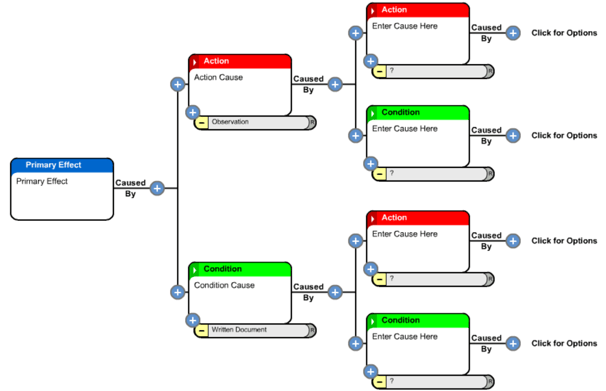
The Apollo Root Cause Analysis methodology demands an exhaustive search for both condition causes and action causes. If you only see half of the problem, will you really understand it? If you only find half of the causes, you will also only have half of the opportunities for controlling or mitigating the problem to an acceptable level.
Let’s take a look at an example – “An Object Fell Off a Platform”
“What happened to make the object fall?” would be a good question to ask. Let’s say someone kicked it off the platform. This is the direct cause of why the object fell, so this is considered an action cause. It is the ‘something’ that happened. An action cause will typically be described using a noun/verb connection as in ‘object /kicked.’
But it’s not always that simple. There are other causes that have played a role in this scenario. At this point in time it is important to challenge the concept of the linear connection of causes and keep searching for more.
The “Every Time Statement”
A useful tool to apply in this scenario is an “Every Time Statement.” The statement itself should be absolute in the sense that all causes in the connection need to be present. The same effect should happen each time the action occurs.
So, every time you kick the object off the platform it will fall? No, not every time.
Why not? Because, the object in question must be elevated. If you kick it while it is on the ground it will not fall.
So is this an action cause or a condition cause?
It is a state of where the object was at the time it was kicked. So in this instance this cause would be labelled as a condition.
Now that another cause has been identified, you can repeat the “Every Time Statement.”
Every time you kick the object off the platform and the platform is elevated, the object will fall. Every time? Well, it will only be true if there is gravity in play. If there is no gravity present, then this statement will not be true.
Is gravity an action or a condition? It’s not an event, it just exists. It was there when the problem occurred. This means that we would label this cause as a condition.
There are now three causes in this causal relationship, but have we identified every cause in that causal connection? At this point we have:
- Kicked object off platform
- The platform was elevated
- Gravity was present
Will the object fall every time? Only if the object has a mass which is greater than that of air. If it were lighter than air, then it would not fall.
Is this cause an action or a condition? Again we observe that the object’s mass didn’t change. Its mass was what it was before the incident and had been so for some time. This makes this cause a condition.
Encourage people in the RCA group to actively look for the exception that makes a lie out of the “Every Time Statement.” Every time you find an exception to this statement you have effectively identified another cause. Add it to your list of causes and repeat the “Every Time Statement.” When you can’t identify any other exceptions then you should have effectively identified every cause in that causal connection. The statement should now be absolute.
So what we have identified here is that there are at least four causes in this causal relationship that will influence whether an object will fall or not. In fact, every time something falls the same types of causes will be in play. The action cause will still need to occur, but this may come in different forms. The action can be different but it will still make use of the available conditions.
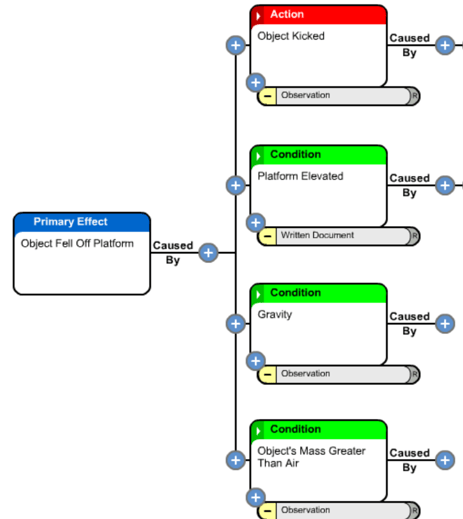
To Sum Things Up
It is valuable to be able to label causes as either actions or conditions. The process of labelling causes demands that you find multiple causes for each connection. This in itself will challenge your understanding of the problem.
Understanding what the conditional causes are will also lead you to finding the most effective solutions for your problem - the hard controls. By actively engaging in challenging the logic of each and every connection within the cause and effect chart consistently, many more conditional causes will be found and more options of control will present themselves. When you have the ability to eliminate a conditional cause, substitute it, or engineer it out, then your solutions and their outcomes will be more consistent, reliable, and predictable. You can therefore, with a fair degree of certainty, declare that the problem will not recur.
Topics: root cause analysis, rca success, rca skills, critical rca skills, root cause analysis tips
How to Avoid the RCA Corrective Action Graveyard
Posted by Jessica Peel on Wed, Jun 22, 2016 @ 03:06 AM
Many of us have them. The invisible “graveyard” where good intentions (AKA – corrective actions from your root cause analysis investigation) went to die.

We all know that all the time and money spent on a root cause analysis investigation and identifying solutions is worthless if the solutions are not implemented. An investigation can usually be done within a week but solutions can take much longer to implement. They sometimes require the involvement of multiple teams or departments, regulatory agencies, engineering, planning, budgeting, and the list goes on and on. For these reasons, it can be challenging to stay on top of all the corrective actions you identified in your investigation, who’s responsible, and the status of an action item at any given time.
We can offer a few basic tips that will give you a head start in tracking action items effectively:
- Be clear about who is responsible for each corrective action. You don’t want to create the opportunity for people to be able to pass the buck with “I thought Bob was going to do it”.
- Have a mechanism in place by which the implementation of corrective actions can be tracked.
- Give ownership of a solution to an individual, not a group or department.
- Assign a due-date for each corrective action.
- Support people in their efforts to implement corrective actions.
- Make sure you follow up on each corrective action – check back with the individual responsible to make sure that progress is being made.
But even these “basics” are easier said than done.
In reality, most likely you come out of your root cause analysis investigation with a list of action items for which various people are responsible. Then everyone goes about their regular workdays and may or may not remember to follow through on any additional tasks they were assigned. Even if you have an appointed person to follow up with the action items and make sure they’re on track, it can be difficult to keep up with who has done what. Many managers rely on an Excel spreadsheet to manually track what has and hasn’t been done, due dates, and so forth. But this puts a lot of pressure on one person to keep up with everything – to manually send reminders to folks who haven’t completed their tasks and to enter the information properly when it has been done.
Even when the Excel file has been carefully kept up-to-date, it often lives locally on the manager’s hard drive, and other members of the team don’t have any visibility as to what has and hasn’t been done.
Sound familiar?
If your RCA program is starting to mature it may be time to consider an enterprise solution to help you better manage all your investigations.
Corrective action tracking inside of an enterprise RCA tool can help you maintain visibility and accountability by tracking the status of action items and assigned solutions. Team members get sent automatic reminders of incomplete or overdue action items and they can easily update the status of their assigned tasks, instantly informing everyone when a task has been completed. You can also create personalized dashboards with reports showing open, completed, or overdue corrective actions.
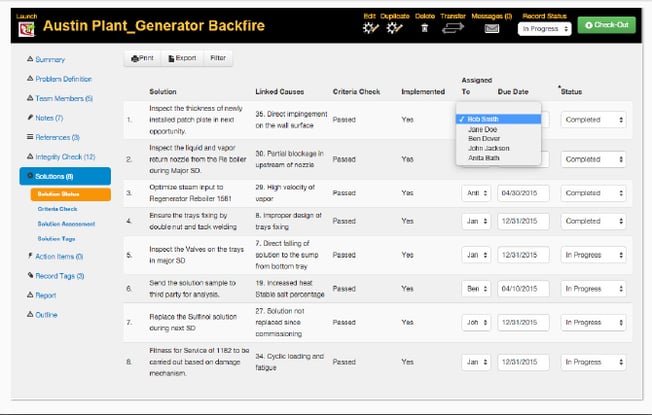
In addition to effective action tracking, an enterprise RCA solution can more broadly help your company implement and manage an effective overall root cause analysis program.
Here are some of the main features to look for:
Enterprise-wide visibility of your RCA programExpand the RCA knowledge base and accessibility across an organization.
Leverage information from previous investigations in your current investigation.
Classify and tag files for easy search-ability. Create custom tags incorporating company or industry standards.
Create and share interactive KPI reports
Build reports on your chosen metrics and visually display key performance indicators in tables, charts and graphics.
Specify which reports are most important to you for immediate dashboard display on your home page.
Preserve integrity by securely collecting and storing evidence and important reference files.
Store company corporate standards or reference files such as frequently referenced industry documents in a central location for immediate access when facilitating an RCA.
Communicate with all users through on-page messaging that lets you quickly share information, receive feedback and record comments.
Remember, in order to resurrect your RCA investigation corrective actions, start with the basics that we listed at the beginning of this article. But also keep in mind – the more mature your RCA program becomes, or the larger and more complex your organization, the larger and more complex your problems become. So when you’re ready to alleviate this pain point altogether, consider whether an enterprise RCA solution might be the next step in your program’s development.
Topics: root cause analysis, rca skills, rca facilitation, corrective actions
3 Simple RCA Facilitation Tips
Posted by Jessica Peel on Wed, Mar 02, 2016 @ 06:03 AM

“How long should an RCA take?”
This question is similar to how long is a piece of string?
I have heard one manager in a plant that has stipulated a maximum of two hours for an RCA to be conducted in his organisation. Another expects at least “brainstormed” solutions before the conclusion of day one – within 6 or 7 hours. It is not uncommon for a draft report to be required within 48 hours of the RCA.
The following three tips may assist to meet tight deadlines and when time expectations are short. One advantage of the Apollo Root Cause Analysis methodology is that it is a fast process but the “driver” has to be on the ball to achieve the desired outcomes – effective solutions.
Tip #1 You Define The Problem
Imagine the RCA has been triggered by an unplanned incident or event which falls into any of the safety, environment, production, quality, equipment failure or similar categories. You have been appointed as the facilitator by a superior/manager who is responding to the particular event. Your superior/manager may understand the trigger mechanism and may well nominate the problem title.
For example, “upper arm laceration”, “ammonia spill”, “production delay” and so forth could be the offering you make to the team as the starting point for the analysis. Typically, as facilitator you will have gathered some of the “facts” from first responder reports, interviews, data sheets, photographs and so on. So a good first step is to draft a problem definition statement, including the significance reflected by the consequences or impacts. The team then has a starting point to commence the analysis, albeit the problem statement may change as more detail is provided.
Ideally, you will have already created a file in RealityCharting™ and the Problem Definition table can be projected onto a screen or even onto the clear wall where your charting will be done with the Post-It™ notes. The team members’ information ought to have been entered and can be confirmed quickly in this display. You might even show the Incident Report format and focus on the disclaimer option you have selected deliberately: Purpose: To prevent recurrence, not place blame.
This preparatory work could save at least 20 minutes of the team members’ time and enable an immediate launch into the analysis phase.
Important: Save yourself hours of re-work and potential embarrassment by saving the file as soon as this first process is complete, if you haven’t already done so, and thereafter on a regular basis. Maintain some form of version control so that the evolution of the chart in the following day/s can be tracked if necessary.
If you are particularly well-resourced the chart development might be recorded on the software simultaneously as the hard copy is created on the wall space. A small team might choose to create the chart directly via the software and a decent projection medium.
Tip #2 Direct The Analysis
It is critical that your initiative in preparing the problem definition is not considered by the team members as disenfranchising them. The analysis step whereby all have an opportunity to contribute should ensure that they feel they have “ownership” of the problem.
To reinforce this, it is advisable to choose a sequence of addressing each member, typically from left to right or vice-versa depending on the seating arrangements. This establishes the requirement that one person is speaking at a time, secondly, that each and every statement will be documented and thirdly, that every person has equal opportunity. Your prompt and verbatim recording of each piece of information will provide the discipline required to minimise idle chatter which can waste time because it distracts focus. When you have a series of “pass” comments from team members because the process has exhausted their immediate knowledge of events, launch the chart creation.
It is worthwhile reminding the team that each information item that has been recorded and posted in the parking area, may not appear in their original form on the chart or at all, in some cases. Because the information gathering is a widespread net to capture as much knowledge regarding what happened, when and why, there will be no particular focus. But because they are coming from people with experience and expertise or initimate knowledge of events and
circumstances, they have some value. The precise value will be determined by where the information sits in the cause and effect logic that starts at the problem and is connected by “caused by” relationships.
Important: Cause text should be written in CAPITAL LETTERS. It will be easier to read/decipher for the team at the time and perhaps from photographs of the chart later. Similarly using caps in the software itself means that projection of the chart is more effective and the printing of various views is enhanced.
Tip #3 The "How and If" of Creating a RealityChart
Many proponents tap the existing understanding of the event by capturing as many of the action causes as possible. These may arrive via a 5 WHYS process, for example, which starts at the Primary Effect.
Plant Stopped (Problem or Primary Effect)
Why? Feed pump not pumping
Why? Broken Coupling
Why? Motor Bearing Seized
Why? Bearing race Collapsed
Why? Fatigue
The Apollo RCA method requires use of the expression “caused by?” to connect cause and effect relationships. Understanding that there must be at least one action and one condition helps reveal the “hidden” causes and especially the condition causes which do not come to mind initially.
To support this expression and the essential “why”, consider asking “how”. This may be employed initially by the most impartial member of your team who has been engaged specifically because of his/her lack of association with the problem and can sincerely ask the
supposedly “dumb” questions. Invariably these questions generate more causes or a more precise arrangement of the existing causes. A “How does that happen exactly?” question can drive the team to take the requisite “baby steps”. This also often exposes differences between “experts” and the resolution of these differences is always illuminating.
The facilitator needs to be aware of the need to softly “challenge” the team’s understanding while ensuring the application of sufficient rigour to generate the best representation of causal relationships. This can be done in a neutral manner by using the “IF” proposition.
Given that every effect requires at least two causes, you can then address the team with the proposition: “If ‘one exists’ and ‘three exists’ (two conditions) then with ‘four added’ (the action) will the effect be “eight” every time?”. Using this technique on each causal element will generate the clarity and certainty being sought to understand the causes of the problem. If every “equation” (causal element) in the chart is “real” and the causes themselves are “real”
(substantiated by evidence) then the team is well-placed to consider the types of controls it could implement to prevent recurrence of the problem.
The more causes which are revealed the more opportunities the team has to identify possible solutions.
Summary
To speed up the RCA process,
Step 1 Facilitator gathers event information and fills out Problem Definition Statement.
Step 2 Facilitator directs the Information gathering casting a wide net and systematically requests information from participants.
Step 3 Use information gathered to build a RealityChart™ with actions based on what happened then looking for other causes such as conditions which may initially be hidden. Use how and If to help validate that causal relationships are logical.
With a completed chart the solution finding step can begin.
Topics: root cause analysis, rca skills, rca facilitation
My Experience Applying RCA Teachings - A Conversation Between Teacher and Student
Posted by Jessica Peel on Fri, Feb 05, 2016 @ 09:02 AM

Creating a common reality is a part of the foundation of the Apollo Root Cause Analysis methodology. It is important that language and definitions are consistent among all parties involved. When the Apollo Root Cause Analysis methodology is applied correctly everyone who participates truly understands the value of the problem, what the solutions are and how they will affect the problem.
Establishing a universal reality is a bigger challenge than you might think. No one shares the exact same experiences or interprets information in the exact same manner. Good problem solvers know to take these different perspectives into account as they forge a path to the solutions.Just as individuals apply their own unique perspective when conducting specific RCAs, companies apply their unique organizational culture when implementing an RCA process. Establishing company standards by defining an RCA champion with clear expectations and implementation procedures in place will keep your organization on the path to RCA success.
Another way to stay at the top of your game is to learn from the experiences of industry peers. Here we take a look at a conversation between Tom, an Engineering Team Lead and RCA champion and Jack, an expert Apollo Root Cause Analysis methodology instructor.
Tom (Engineering Team Lead):
I have found that sometimes engineers and technicians do not have a real understanding of the meaning of “root cause.” They tend to think of it as a single poor design feature or failure like a “loose nut” or a single cause of the issue or failure. They seemed to be surprised when I recently identified ten root causes on the last job. They were confused and could not get their heads around having ten root causes. They said, “But what was the real single root cause?”
Jack (RCA Instructor):
You are so right. Many people have preconceived idea that there can only be one root cause. They are driven by this perception to that end. It is quite a limiting concept for those people. They can become quite tunneled in their thinking, offering a close-minded approach to their problems rather than an all-embracing search for knowledge and information that could lead to enlightenment. Some anecdotal information even suggests that this mind frame is taught and it quite difficult to rattle their cages and try to shift their paradigms. How do you define root cause?
Tom:
I define root cause as an opportunity for improvement. A single root cause cannot exist on its’ own, there must also be at least one condition. Here, I cannot come across as too much of a know-it-all or people roll their eyes, so I need a quick snappy go to response that is quick and brief and simple and does not come across as a nerd or a geek. That’s just where I work, as there are no formal RCA people in this division – we all share the work on investigations and most are engineering failure investigations that I do out of my own volition, and share with my team. In your experience, what are the major setbacks you have seen with people applying the RCA process? I’d like to get better and avoid these mistakes.
Jack:
You are doing a great job, persevere. Changing peoples’ perspectives takes time especially if you are the only one flying the flag. A major key to success is making sure you are asking enough questions and following a process that demands these questions be asked. Sometimes people take shortcuts to speed up the process…less to think about…less time…must be better! And they can still argue that they have a solution. For simple problems this may even work and they could achieve a satisfactory result, but for complex problems this approach simply doesn’t come close to being comprehensive enough. The lack of knowledge and training in this area now comes back to bite them and their problems invariably don’t go away. Without a solid RCA foundation and process in place the structures within the company they work for won’t raise any red flags that something may be incorrect or ineffective in any way….so the end product of a subpar RCA (the report) is accepted. If management doesn’t embrace the change then reverting to old acceptable habits is just easier. The key to avoiding these major failures lies in overcoming the resistance to change. Involving your team in the RCA process and sharing your successes with management is a great way to gain support.
Tom:
I got into the habit of now actually doing an initial draft RCA live in front of my team. I draft the RCA in a bound book which I have dedicated to this purpose and follow the cause and effect pathways like the software. I feel like this approach is more relatable with my team and I am able to get their input quickly. We are usually able to identify half a dozen possible causes in just a few minutes. Afterwards I go to the software and expand on it. Then I formalize and save the RCA in the software which checks all my work.
Hope you are in Sydney sometime soon, Jack. Your teaching techniques really work and I liked your style. I think in 20 years of taking training your lessons are the ones that have stuck the most with me.
If you have  questions or ideas to share and would like to connect with people who have been trained in the Apollo Root Cause Analysis methodology with ARMS Reliability join our Apollo Root Cause Analysis methodology discussion group on LinkedIn.
questions or ideas to share and would like to connect with people who have been trained in the Apollo Root Cause Analysis methodology with ARMS Reliability join our Apollo Root Cause Analysis methodology discussion group on LinkedIn.
Topics: root cause analysis, rca skills, rca facilitation
RCAs Don't Need To Take Several Days
Posted by Kevin Stewart on Tue, Dec 08, 2015 @ 04:12 AM
By Kevin Stewart
Many of the Apollo Root Cause Analysis methodology training instructors often get asked the same question – “how long should it take to do a Root Cause Analysis (RCA) investigation?” This is a difficult question to answer due to the variables associated with each individual RCA. It’s a lot like asking someone, “How long will the trip take?” How do you begin to answer that? Some questions that come to mind are – to where? Or how will you be traveling? Or what route will you take? Or will you be stopping anywhere? And so on.
If it is so variable, how can we even talk about whether an RCA should take several days or not? There are two general paths in the utilization of the Apollo methodology, let’s call them “long” and “short.” Since this article is about RCAs not taking several days, let’s focus on the short one. 
Most people envision the Apollo Root Cause Analysis methodology as a large group of people in a conference room for several days as a necessary means to finding a valid solution. It is true that many RCA investigations do take four to five solid, eight-hour days to determine an appropriate solution, but these should be problems that have a large significance where information may not be readily available.
I always point out to my students that not only is it possible to do an Apollo Root Cause Analysis in a short time, but I have personally done several that took less than a day. How?
The Apollo Root Cause Analyisis process involves a specific methodology of asking “why?” or “caused by ____?” and then identifying an appropriate answer, writing it down, and then asking “why” again. You do this until you are stymied with no answers or reach a point where it doesn’t make sense to ask “why” anymore. This process does not change regardless of the type or the size of the problem, or for any other reason.
Many of you may have heard of the “Five Whys” as an RCA process. This was designed for small problems experienced by operators on the line at Toyota facilities. These little RCAs were done in the moment by people involved in the incident. If you’re familiar with both the Apollo Root Cause Analysis methodology and Five Whys process you may notice that they are very similar. Many times I point out to students that you can see several “Five Whys” branches inside any Apollo RCA chart. So it stands to reason that the Apollo Root Cause Analysis methodology can be used in a similar fashion to the Five Whys.
Here’s an example. I was responsible for the reliability of a production area of a plant during my career. It was not uncommon to find me walking around looking for problems, and during one such time I discovered some people working hard to unplug a jammed conveyor. It was plugged with a 1,000-pound solid carbon block wedged in between some posts, and there was no good access to the block with a crane or other lifting device. When they spotted me I got an earful; apparently this had been happening on a regular basis. The specific frequency was unknown, but the emotion of the operator told me that it was at least once per shift. I promised to fix it for him and he calmed down, they got the unit unplugged and back on line, and he went back to his job just downstream of the jam.
Since I promised to fix this, I decided to spend some time at the unit to see if I could observe what was causing the jam.
The Apollo Root Cause Analysis process went like this:
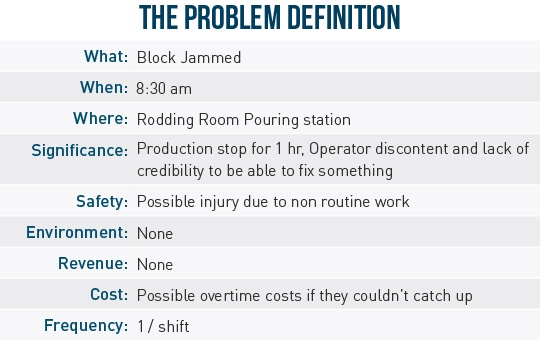
If you start the RCA chart in your mind, you quickly get to a dead end because no one could see why the jam had happened. The operator in the area was busy doing his job, which required constant attention—pouring molten metal into a small cavity to “glue” a copper rod to the top of an anode. This was done while the line was moving; he poured one about every 15 seconds so he really couldn’t be looking around. There were not a lot of other spare personnel in the area that could spend the time looking, so I decided that was my job. 
These blocks where pushed onto an automated system by a large pusher that had a paddle hanging down from a cylindrical steel piece with a bushing, since the paddle was designed to float. It seemed pretty obvious that the pusher had something to do with it… but how? After they started up the system, it worked like a charm just as designed, no glitches. Intermittent problems are some of the hardest to fix because you need to be there when things go awry or gather data to identify the causes.
So there I was with one cause on my box – “Block jammed caused by ____?” I thought perhaps if I watched it I’d get lucky enough to catch the issue. So I stood there, and stood there, and stood there for perhaps an hour. Nothing. I didn’t want to leave quite yet but it did seem like a waste of time, so I decided to check out other items in the area. I spent an hour or so away from the machine and then went back. Upon returning to the unit there didn’t seem to be anything obviously out of order. However, something seemed different, though I couldn’t put my finger on it.
After spending another hour away and then coming back again, this time I noticed what appeared to be a difference: slight, but I was pretty sure it was happening. One more hour away and then back and sure enough something was happening over a long period of time.
Now I just needed to verify my suspicions. Believing I knew the cause, I figured I had enough time to go to lunch and do some more office work before returning to the unit to check my theory and gather evidence. I was correct.
The cause of the issue was that the paddle was rotating counter-clockwise on the shaft ever so slightly with every push. It was taking more than six hours for it to rotate enough to push on the corner of the block, shove it sideways off the conveyor, and cause the jam. So my chart looked like this after about six to seven hours:
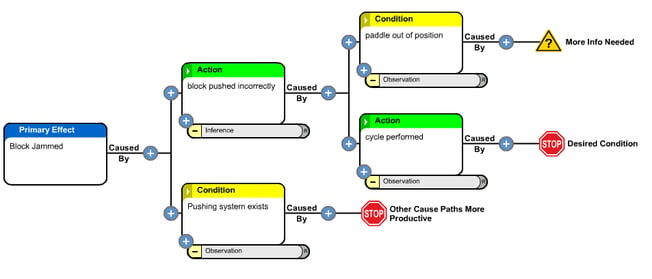 At this point I alerted everyone to the issue, and the maintenance personnel came over and safely moved the paddle back so the shift could finish. Our facility had a swing shift crew that worked in the area after the production was done, so they were assigned the task of fixing the unit.
At this point I alerted everyone to the issue, and the maintenance personnel came over and safely moved the paddle back so the shift could finish. Our facility had a swing shift crew that worked in the area after the production was done, so they were assigned the task of fixing the unit.
That evening they removed the unit, checked everything against the drawings and specifications, and found that the tolerance on the bushing was incorrect. It was close, but the tolerance was tight enough that each push that was not exactly dead-on caused a slight twisting force, moving the paddle off course and eventually causing a jam. The team fixed the tolerance issue and put it back in place by the next shift start.
So my chart now looked like this:
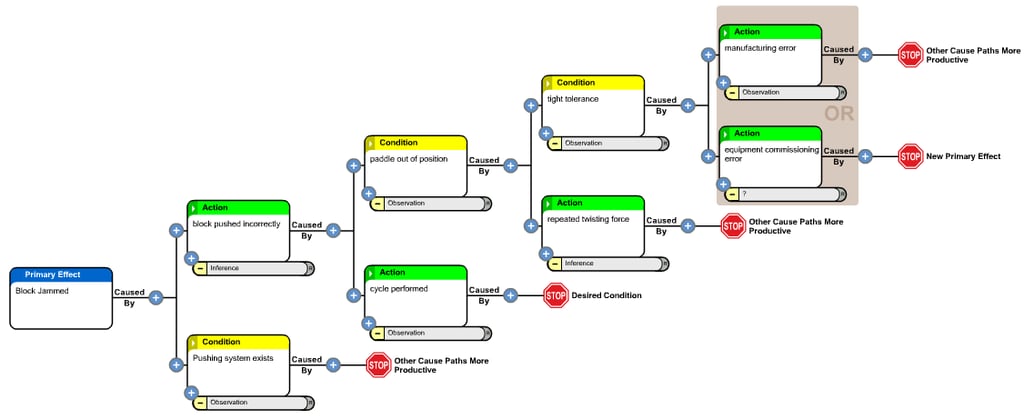
This whole process took less than eight hours to complete but was spread out over two days. If you look at my total time involvement it was perhaps four hours. (I am not charging the process with time that I was multitasking by doing other things.)
So as you can see, an RCA investigation doesn’t always have to take days. Of course, some will take several days and you could stretch even a simple investigation into a longer process if you wish. But if you are close to the problem, get accurate information, act quickly, and stick with the process, you can do an RCA quickly and get an effective solution.
Topics: root cause analysis, rca skills, rca facilitation
Top 6 Sure-Fire Ways to Kill off a Root Cause Analysis Program
Posted by Lou Conheady on Wed, Sep 24, 2014 @ 15:09 PM
Author: Jack Jager
An effective root cause analysis process can improve business outcomes significantly. Why is it then that few organisations have a functioning root cause analysis process in place?Here are the top 6 sure-fire ways to kill off a Root Cause Analysis program
1. Don’t use it.

The company commits to the training, creates an expectation of use and then doesn’t follow through with commitment, process and resources! Now come on, how easy is it to devalue the training and deliver a message that the training was just to tick someone’s KPI box and that the process doesn't really need to be used.
2. Don’t support it.
Success in Root Cause Analysis would be the ultimate goal of each and every defect elimination program. To achieve success however, requires a bit more than just training people in how to do it. It requires structures that initially support the training, that mentor and provide feedback on the journey towards application of excellence and thereafter have structures that delineate exactly when an investigation needs to take place and that delivers clear support in terms of time and people to achieve the desired outcome. Without support for the chosen process the expected outcomes are rarely delivered.
3. Don’t implement solutions.
To do all of the work involved in an investigation and then notice that there have been no corrective actions implemented, that the problem has recurred because nothing has changed, has got to be one of the easiest ways to kill off a Root Cause Analysis process. What happens when people get asked to get involved in RCAs or to facilitate them when the history indicates that nothing happens from the efforts expended in this pursuit? “I’m too busy to waste my time on that stuff!”
4. Take the easy option and implement soft solutions.
Why are the soft controls implemented instead of the hard controls? Because they are easy and they don’t cost much and we are seen to be doing something about the problem. We have ticked all the boxes. But will this prevent recurrence of the problem? There is certainly no guarantee of this if it is only the soft controls that we implement. We aren’t really serious about problem solving are we, if this is what we continue to do?
5. Continue to blame people.
The easy way out! Find a scapegoat for any problem that you don’t have time to investigate or that you simply can’t be bothered to investigate properly. But will knowing who did it, actually prevent rec urrence of the problem?
urrence of the problem?
Ask a different question! How do you control what people do? You control them or more correctly their actions by training them, by putting in the right procedures and protocols, by providing clear guidelines into what they can or can’t do, by creating standard work instructions for everyone to follow and by clearly establishing what the rules are in the work place that must be adhered to.
What sort of controls are these if we measure them against the hierarchy of controls? They are all administrative controls, deemed to be soft controls that will give you no certainty that the problem will not happen again. We know this! So why do we implement these so readily? Because it is the easy way out! It ticks all the boxes, except the one that says “will these corrective actions prevent recurrence of the problem?”
We all understand the hierarchy of controls but do we actually use it to the extent that we should?
6. We don’t know if we are succeeding because we don’t measure anything.
You get what you measure! When management don't implement or audit a process for completed RCAs it sends a strong message that there is no interest, or little, in the work that is being done to complete the analysis.
Tracking KPIs like, how many RCAs have been raised against the triggers set? How many actions have been raised in the month as a result and, of those actions raised, how many have been completed? If management is not interested in reviewing these things regularly along with the number of RCAs subsequently closed off in a relevant period, then it won't be long before people notice that no one is interested in the good work being done.
The additional work done to complete RCAs will not be seen as necessary, as it's not important enough to review and the work or the effort in doing this will then drop away until it's no longer done at all.

Another interesting point is that if only the number of investigations is reported, and there is no check on the quality of the analysis being completed, then anything can be whipped up as no one is looking! If a random audit is completed on just one of the analyses completed in a month then this implies that the quality of the analysis is important to the organisation.
What message do we send if we don’t measure anything?
In closing, the first step on the road to implementing an effective and sustainable Root Cause Analysis program is to pinpoint what's holding it back. These Top 6 sure-fire ways to kill off a Root Cause Analysis program will help you identify your obstacles, and allow you to develop a plan to overcome them.
Topics: root cause analysis, rca success, rca skills, root cause analysis skills, root cause investigation, root cause of success, root cause analysis tips, success definition, root cause analysis program
How to Judge the Quality of an RCA Investigation
Posted by Lou Conheady on Tue, Sep 02, 2014 @ 14:09 PM
Author: Kevin Stewart
This question was posed to a discussion group and it got me thinking how do you grade an investigation?
The overall success will be whether the solution actually prevents recurrence of the problem. One definition of Root Cause Analysis is: “A structured process used to understand the causes of past events for the purpose of preventing recurrence.” So a reasonable assessment of the quality of the analysis would be to determine whether the RCA addressed the problem it set out to fix by ensuring that it never happens again (this may be a lengthy process to prove if the MTBF of the problem is 5 years, or has only happened once). 
Are there some other tangibles that can help you assess the quality of an RCA? RCAs use some sort of process to accomplish their task. If this is the case then it would stand to reason that there will be some things you can look for in order to gauge the quality of the process followed. While this is no guarantee of a correct analysis, ensuring that due diligence was followed in the process would lend more credibility to the solutions.
What are some of these criteria by which you can judge an analysis?
- Are the cause statements ‘binary’? By this we mean unambiguous or explicit. A few words only and precise language use without vague adjectives like “poor” since they can be very subjective.
- Are the causes void of conjunctions? If they have conjunctions there may be multiple causes in the statement. Words such as: and, if, or, but, because.
- Is there valid evidence for each cause? If causes don't have evidence they may not belong in the analysis or worse yet solutions may be tied to them and be ineffective.
- Does each cause path have a valid reason for stopping that makes sense? It is easy to stop too soon and is sometimes obvious. For example, if a cause of “no PM” has no cause for it so that the branch stops, it would seem that an analyst in most cases would want to know why there was no PM.
- Does the structure of the chart meet the process being used? If it is a principle-based process then it should be easy to check the causal elements to verify that they satisfy those principles. These might be causal logic checks or space time logic checks or others that were associated with the particular process.
- Is the chart or analysis completed? Does it have a lot of unfinished branches or questions that need to be answered or action items to complete?
- Is the chart or analysis completed? Does it have a lot of unfinished branches or questions that need to be answered or action items to complete?
- Are the solutions SMART (Specific, Measurable, Actionable, Relevant, and Timely)? Or do they include words like: investigate, review, analyze, gather, contact, observe, verify, etc.
- Do the solutions meet a set of criteria against which they can be judged?
- Do the solutions address specific causes or are they general in nature? Even though they may be identified against specific causes if they don’t directly address those causes then it may still be a guess.
- If there is a report, is it well written, short, specific and cover just the basics that an executive would be interested in? Information such as cost, time to implement, when will it be completed, a brief causal description and solutions that will solve the identified problem are the requisites.
These are some of the things that I currently look at when I review the projects submitted by clients. I’d be interested to know about other things that may be added to the list.
Topics: root cause analysis, rca facilitator, rca success, rca skills, root cause analysis skills, rca facilitation, root cause investigation, critical rca skills, root cause of success, root cause analysis tips, facilitation skills
Honing your Facilitation Skills: Part 2
Posted by Jo Quinn on Tue, Aug 12, 2014 @ 16:08 PM
By Kevin Stewart
With all the preparation work (Honing your Facilitation Skills: Part 1) behind you, you’re now ready to start facilitating an Apollo Root Cause Analysis. Follow the steps below to ensure a smooth process and successful outcome.
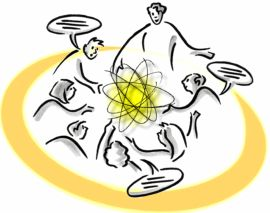
Step 1. Introductions
First, do some simple introductions and housekeeping. Cover things like:
- Introductions all around
- The meeting guidelines: when to take breaks, phone and email policy, and so on
- The objective: we’re here to fix the problem, not appoint blame
- A review of the Apollo Root Cause Analysis methodology for those who may not be familiar with it (spend 15 – 45 minutes depending on the audience)
- Your role as facilitator: you may need to ‘direct traffic’ or change the direction of discussions to help them discover more causes or to reach effective solutions
Step 2. Timeline
It’s now time to capture the ‘story’. What has happened that brought you all here? Get several people to provide a narrative, and develop a timeline of events as you go.
This timeline will prove very useful. It should reveal the event or issue that becomes your primary effect or starting point – and ensures that all the items beyond this starting point capture the group’s issues.
In the example below, if I start from T1 I’ll discover why I left my iPad in the bathroom. However if I start at T7 I will also discover why my check process didn’t function as desired.
| Date | Time | Event | Comment |
| T1 | Leave iPad in department restroom stall | ||
| T2 | Meet wife | ||
| T3 | Have lunch | ||
| T4 | Return to car to leave | ||
| T5 | Wife asks if we have everything before we leave | ||
| T6 | Pat pocket and look, run through check list | ||
| T7 | Head home without iPad | ||
| T8 | Get call halfway home asking if i have iPad |
While the time that each event occurs is important, it might not always be known. In these instances, you can represent the time sequence as simply T1, T2 and so on.
Step 3. Define the problem
You’re now ready to define the problem. Often, the problem definition comes out easily and everyone agrees. However, sometimes you’ll find that the group can’t arrive at a Primary Effect. In this case, as facilitator, it’s your job to regroup and ask some questions about why everyone is interested. Often, it’s about money.
One thing you don’t want to do is get stuck trying to find the perfect starting point. I’m reminded of a saying I heard once:
Dear Optimist and Pessimist,
While you were trying to decide if the glass was half empty or half full, I drank it!
Sincerely,
The Realist
The Apollo Root Cause Analysis methodology is robust enough to handle an imperfect starting point. If the problem changes or evolves as you go, just put it down as the new starting point, adjust the chart and go on!
Now that you have a defined problem, with its significance well understood, you’re now ready to start the charting process. The team should also know by now why they’re here, and how much time and money can be spent on the investigation.
If you missed Part 1 of this article, you can read it here.
Would you like to learn more about the Apollo Root Cause Analysis methodology? Our 2 Day Root Cause Analysis Facilitators course is perfect for anyone needing to understand fundamental problem solving processes and how to facilitate an effective investigation.
Topics: root cause analysis, rca facilitator, rca skills, root cause analysis skills, rca facilitation, root cause investigation, facilitation skills, root cause analysis program, root cause facilitation, rca facilitators, root cause analysis reporting
Root Cause Analysts Tips & Tricks - 101 Ways to improve your RCA Investigations
Posted by Susan Rantall on Wed, Sep 25, 2013 @ 00:09 AM
Our latest eBook gives you access to all our top tips for conducting better root cause analysis investigations.
We've covered root cause analysis from start to finish:
-
Gathering information
-
Assembling the team
-
Conducting the RCA
-
Implementing the solutions
-
Measuring the success of the corrective actions
-
Advertising your successes
-
Plus, a whole section of tips for the RCA facilitator
Topics: root cause analysis, rca skills, rca facilitation, root cause investigation, critical rca skills, root cause analysis tips





